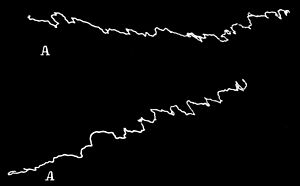mind, and it is essential to determine in what measure each appears in the general result.
If you hold out your arm nearly on a level with the shoulders and in line with them, you perceive at once that movements of  Fig. 4. ↦ Counting Metronome. Right hand holds pencil, left hand holds record; time of each, 90 seconds. Facing ↦. Upper line, standing; lower line, sitting. the hand to the front are much more readily made than to the rear, and movements toward the body more readily than those away from the body; the tendency of the hand is to move along a circle of which the shoulder is the center. What we require is a position in which movements in any direction are as readily made as in any other; and this may be approximated, though only approximated, by holding the hand at an angle of about 45° with the line joining the shoulders, and with the elbow bent at an angle of about 120°; this position[1] is
Fig. 4. ↦ Counting Metronome. Right hand holds pencil, left hand holds record; time of each, 90 seconds. Facing ↦. Upper line, standing; lower line, sitting. the hand to the front are much more readily made than to the rear, and movements toward the body more readily than those away from the body; the tendency of the hand is to move along a circle of which the shoulder is the center. What we require is a position in which movements in any direction are as readily made as in any other; and this may be approximated, though only approximated, by holding the hand at an angle of about 45° with the line joining the shoulders, and with the elbow bent at an angle of about 120°; this position[1] is

| Fig. 5.—Thinking of a Building. Facing ↥; standing. Right hand holds pencil, left hand holds record; time of each, 60 seconds. I, ↥; II, ↧; shows respiration. | Fig. 6. Counting Metronome. Right hand holds pencil, left hand holds record. From A to B, ↥; from B to C, ↦; from C to D, ↧; from D to E, ↤; standing; each part, 45 seconds. | |
recommended for the normal tests. The usual result is a movement toward the object of attention; but when that is to the rear, this tendency is sometimes outweighed by the natural tendency
- ↑ In one series we were able to measure the extent of movements in various directions, and found half again as much movement toward the front as toward the rear, and a third again as much toward as away from the body.

